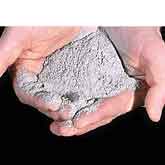What is Volcanic Ash?
 Small jagged pieces of rocks, minerals, and volcanic glass the size of sand and silt (less than 1/12 inch or 2 millimeters in diameter) erupted by a volcano are called volcanic ash. Very small ash particles can be less than 1/25,000th of an inch (0.001 millimeter) across. Though called 'ash,' volcanic ash is not the product of combustion, like the soft fluffy material created by burning wood, leaves, or paper. Volcanic ash is hard, does not dissolve in water, is extremely abrasive and mildly corrosive, and conducts electricity when wet.
Small jagged pieces of rocks, minerals, and volcanic glass the size of sand and silt (less than 1/12 inch or 2 millimeters in diameter) erupted by a volcano are called volcanic ash. Very small ash particles can be less than 1/25,000th of an inch (0.001 millimeter) across. Though called 'ash,' volcanic ash is not the product of combustion, like the soft fluffy material created by burning wood, leaves, or paper. Volcanic ash is hard, does not dissolve in water, is extremely abrasive and mildly corrosive, and conducts electricity when wet.
Volcanic ash is formed during explosive volcanic eruptions. Explosive eruptions occur when gases dissolved in molten rock (magma) expand and escape violently into the air, and also when water is heated by magma and abruptly flashes into steam. The force of the escaping gas violently shatters solid rocks. Expanding gas also shreds magma and blasts it into the air, where it solidifies into fragments of volcanic rock and glass.
Once in the air, hot ash and gas rise quickly to form a towering eruption column, often more than 30,000 feet, (9144 m) high. Larger rock fragments more than 2 inches, (5 cm) across ejected by the explosion typically fall within a few miles of the eruption site. However, wind can quickly blow fine ash away from the volcano to form an eruption cloud. As the cloud drifts downwind from the erupting volcano, the ash that falls from the cloud typically becomes smaller in size and forms a thinner layer. Ash clouds can travel thousands of miles, and some even circle the Earth.
Fact Credit
USGS General


